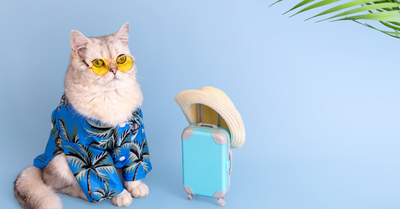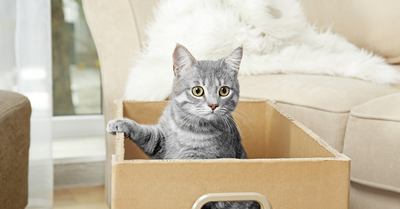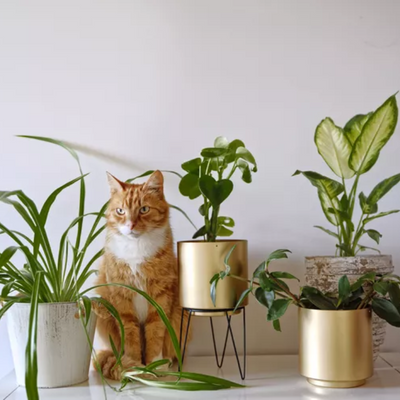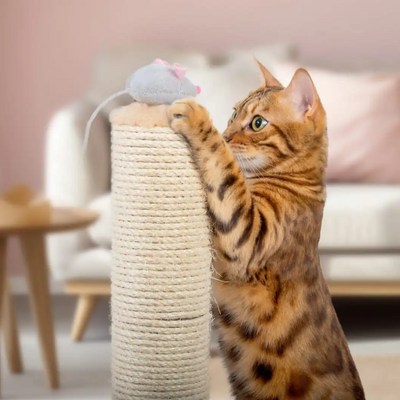News
Blog posts
Traveling with Your Cat: Tips for a Smooth Journey
For many cat owners in Singapore, traveling with their feline companion can feel daunting. Whether you’re planning a short trip to the vet or a long-haul flight overseas, ensuring a stress-free journey for your cat requires careful preparation. Soft Loft, Singapore’s trusted online pet store, is here to guide you with practical tips and essential products that will make your cat’s travel experience safe and comfortable.
1. Choose the Right Carrier for Safety and Comfort

A well-ventilated, secure, and cozy carrier is the most important travel accessory for your cat. Soft Loft offers a variety of cat carriers and strollers designed for different travel needs, from airline-approved carriers to expandable soft-sided bags for added comfort.
Key Features to Look For:
-
Size: Your cat should be able to stand, turn around, and lie down comfortably.
-
Ventilation: Mesh panels ensure airflow and reduce overheating.
-
Security: Lockable zippers prevent escape attempts.
-
Comfort: Padded interiors or space for a soft blanket help keep your cat at ease.
-
Convenience: Options like top-loading carriers or expandable designs add ease of use for both you and your cat.
Recommended Product: Soft Loft’s Airline-Approved Cat Carrier ensures your cat’s safety and comfort during travel.
2. Acclimate Your Cat to the Carrier Before Travel
Many cats dislike being confined, so getting them used to their carrier before the trip is crucial. Start by placing the carrier in your home with the door open and lining it with a familiar blanket or their favorite toy. Gradually encourage your cat to spend time inside by offering treats and praise.
Training Tip:
-
Begin with short sessions of 5-10 minutes and slowly increase the time.
-
Take short car rides with your cat in the carrier to get them accustomed to movement.
-
Use synthetic feline pheromone sprays like Feliway inside the carrier to create a calming environment.
3. Plan for Litter Box Needs on the Go

Cats are creatures of habit, and using the bathroom while traveling can be a challenge. If you’re going on a long journey, consider using a portable, disposable litter box.
Travel-Friendly Litter Box Solutions:
-
Disposable litter trays with odor-control litter.
-
Foldable, compact travel litter boxes that fit inside your cat’s carrier.
-
Pee pads placed inside the carrier for short trips to prevent accidents.
4. Keep Your Cat Calm During Travel
Traveling can be stressful for cats due to unfamiliar surroundings and motion. Consider using natural calming aids or prescribed medications if your cat is prone to anxiety.
Effective Calming Solutions:
-
Feliway pheromone spray: Mimics natural calming pheromones.
-
Calming treats with ingredients like L-theanine or chamomile.
-
CBD oil for pets (vet-approved) for anxiety relief.
-
Mild sedatives (only if prescribed by your veterinarian).
5. Pack Essential Supplies for a Comfortable Trip
To make the journey as smooth as possible, bring along a travel kit with your cat’s necessities:
-
Food and water bowls (collapsible for convenience)
-
Familiar blanket or bedding to provide comfort
-
Favorite toys to reduce boredom
-
Extra litter and disposable bags
-
First-aid kit with emergency supplies
Soft Loft offers a variety of pet travel essentials, including portable food bowls and collapsible litter trays to ensure a hassle-free experience.
6. Research Airline & Hotel Pet Policies in Advance
If you’re traveling by air, always check the airline’s pet policy regarding carrier size, fees, and in-cabin vs. cargo travel. Some airlines that accommodate pets in-cabin for flights from Singapore include:
-
Singapore Airlines (only for service animals)
-
KLM Royal Dutch Airlines
-
Qatar Airways
For accommodations, ensure your hotel or Airbnb is pet-friendly. Platforms like BringFido and Booking.com allow you to filter for pet-friendly stays.
7. Keep Identification and Health Documents Ready

Always have the following documentation in case of emergencies:
-
Microchip registration details
-
Up-to-date vaccination records
-
Pet passport (for international travel)
-
Veterinarian health certificate (required by some airlines)
Soft Loft recommends investing in a custom ID tag or a GPS tracker collar for extra security during travel.
3-Question FAQ
1. How can I keep my cat from getting anxious during travel? Gradual carrier training, calming pheromones, familiar bedding, and natural calming treats can help reduce stress. Consult your vet for additional anxiety solutions.
2. What should I do if my cat refuses to use a travel litter box? Try placing used litter in the travel box to encourage familiarity. If they still refuse, use absorbent pee pads inside the carrier.
3. Can I take my cat in-cabin on flights from Singapore? Some international airlines allow in-cabin travel, but Singapore Airlines only permits service animals. Always confirm with your airline before booking.
Traveling with your cat can be stress-free with proper preparation and the right gear. Soft Loft offers a range of high-quality cat carriers, travel litter boxes, and calming aids to ensure a comfortable journey for both you and your feline friend. Browse our collection today and travel with confidence!
DIY Cat Toys on a Budget: Fun and Affordable Ideas for Your Feline Friend
Cats thrive on play and stimulation, but store-bought toys can be expensive. Fortunately, with a bit of creativity and some household materials, you can make engaging, safe, and interactive cat toys at home. Soft Loft, Singapore’s trusted online pet store, is here to guide you through budget-friendly DIY toy ideas that your cat will love.
1. The Classic Cardboard Box Maze
Cats adore cardboard boxes, making them the perfect material for a stimulating play area.
-
Materials Needed: Several cardboard boxes, scissors, non-toxic glue, and catnip (optional).
-
Instructions:
-
Cut holes in the sides of multiple boxes, ensuring they are large enough for your cat to crawl through.
-
Connect the boxes with tape or glue to create a tunnel system.
-
Sprinkle a little catnip inside to encourage exploration.
-
Why It Works: Encourages natural hunting instincts and provides a safe hideaway for your cat.
2. Sock & Rice Crinkle Toy
A crinkly, scented toy can be irresistible to your feline friend.
-
Materials Needed: An old sock, dry rice, and a knot.
-
Instructions:
-
Fill a clean sock with a handful of dry rice.
-
Tie a secure knot at the top.
-
Let your cat bat, chase, and pounce on it.
-
Why It Works: The crunchy sound mimics prey, keeping your cat entertained for hours.
3. DIY Feather Wand

Interactive play strengthens the bond between you and your cat while promoting exercise.
-
Materials Needed: A wooden dowel, string, and feathers.
-
Instructions:
-
Tie feathers securely to the end of a string.
-
Attach the string to a wooden dowel.
-
Wave it around to mimic a bird’s movement.
-
Why It Works: Taps into your cat’s natural prey drive, encouraging physical activity.
4. T-Shirt Braided Tug Toy
Upcycle an old T-shirt into a durable cat toy.
-
Materials Needed: An old T-shirt, scissors.
-
Instructions:
-
Cut the T-shirt into three long strips.
-
Braid the strips together tightly and knot the ends.
-
Let your cat chew, wrestle, and kick it.
-
Why It Works: Soft but strong texture provides a satisfying chew for teething cats.
5. Toilet Paper Roll Puzzle Feeder
Mental stimulation is just as important as physical exercise for cats.
-
Materials Needed: Empty toilet paper roll, treats, and scissors.
-
Instructions:
-
Cut small holes along the toilet paper roll.
-
Fill it with kibble or treats.
-
Let your cat figure out how to get the treats out.
-
Why It Works: Encourages problem-solving skills and slows down fast eaters.
6. Catnip-Filled Fabric Mouse

A homemade fabric mouse filled with catnip can be a delightful toy.
-
Materials Needed: Scrap fabric, cotton stuffing, catnip, needle, and thread.
-
Instructions:
-
Cut fabric into two identical mouse-shaped pieces.
-
Sew them together, leaving a small opening.
-
Stuff with cotton and catnip before sewing shut.
-
Why It Works: Mimics small prey and keeps your cat engaged with its scent and shape.
7. The Paper Ball Chase
Sometimes, the simplest toys are the best.
-
Materials Needed: A sheet of scrap paper.
-
Instructions:
-
Crumple the paper into a ball.
-
Toss it for your cat to chase.
-
Why It Works: The lightweight ball mimics small prey, stimulating natural hunting instincts.
Recommended Toys from Soft Loft
For those who want professionally designed cat toys that complement DIY options, check out Soft Loft’s Cat Accessories & Supplies. Some must-have products include:
-
Interactive Cat Tunnel: Encourages exploration and hiding.
-
Catnip-Infused Plush Toys: Provides endless entertainment.
-
Hanging Feather Teasers: Perfect for interactive play sessions.
FAQ
-
Are DIY cat toys safe? Ensure all materials are non-toxic and free of small parts that can be swallowed. Avoid loose strings and plastic components.
-
How often should I rotate my cat’s toys? Rotate toys every two weeks to keep your cat engaged and prevent boredom.
-
What if my cat doesn’t seem interested in DIY toys? Try sprinkling catnip on them or engaging in interactive play to encourage interest.
With these budget-friendly, engaging DIY cat toys, you can keep your feline entertained while saving money. Whether you're crafting your own or exploring Soft Loft’s premium collection, ensuring your cat has plenty of stimulation is key to a happy, healthy pet!
Pet-Safe Plants for Your Cat Home
Cats bring joy, companionship, and a touch of mischief to our homes. However, their curious nature means they often nibble on plants, making it crucial to choose pet-safe options. Many common houseplants are toxic to cats, but that doesn’t mean you have to give up on greenery. In this guide, we’ll explore toxic plants to avoid, suggest beautiful and safe alternatives, and share tips on how to incorporate them into your cat-friendly home.
Toxic Plants to Avoid
Before diving into safe plant options, let’s take a look at some common houseplants that are dangerous for cats:
-
Lilies – Highly toxic and can cause kidney failure.
-
Pothos (Devil’s Ivy) – Can lead to oral irritation and vomiting.
-
Sago Palm – Ingesting even a small amount can cause severe liver damage.
-
Aloe Vera – While great for human skin, it’s harmful to cats if ingested.
-
Snake Plant – Can cause nausea, vomiting, and diarrhea.
If you have any of these plants, consider relocating them to a space completely out of reach of your cat or replacing them with pet-safe alternatives.

Safe and Stylish Plant Alternatives
If you want a lush, green home without compromising your cat’s safety, consider these beautiful, non-toxic options:
1. Cat Grass (Dactylis glomerata)
-
Encourages healthy digestion and satisfies your cat’s urge to chew.
-
Easy to grow indoors and adds a fresh touch to your space.
-
Requires regular watering and bright, indirect light.
2. Spider Plant (Chlorophytum comosum)
-
Non-toxic, air-purifying, and resilient.
-
Cats are often attracted to its long, playful leaves.
-
Thrives in indirect light with occasional watering.
3. Areca Palm (Dypsis lutescens)
-
Safe for cats and adds a tropical vibe to your home.
-
Prefers bright, indirect light and moderate watering.
-
Consider the Artificial Areca Palm Plant for an effortless alternative.
4. Boston Fern (Nephrolepis exaltata)
-
Aesthetic, feathery fronds that are completely safe for cats.
-
Requires high humidity and indirect sunlight.
-
Avoid letting it dry out completely.
5. Calathea (Calathea spp.)
-
Known for its striking foliage and pet-safe qualities.
-
Thrives in low-light conditions and high humidity.
-
Keep soil slightly moist but avoid overwatering.

Decorating with Cat-Safe Plants
To integrate these plants into your home while keeping them safe from curious paws, follow these tips:
-
Choose Low-Maintenance Options: Opt for easy-care plants like the Artificial Olive Tree or Artificial Monstera Plant for a hassle-free way to add greenery without worrying about watering or toxicity.
-
Place Plants Strategically: Use high shelves, plant stands, or racks to keep plants out of reach. The Stainless Steel Plant Rack or Single Layer Wooden Rack are great options for elevating your greenery.
-
Use Cat-Safe Planters: Consider decorative planters that add to your home’s aesthetic while keeping your plants secure. Try the Low Round Steel Planter Stand or Imitation Round Plant Pot.
-
Incorporate Artificial Greenery: If your cat is extra mischievous, artificial plants like the Artificial Hanging Plant in Black Pot or Artificial Orchid in Pot are excellent choices for maintaining style without risk.
Bonus Tip: Natural Fragrance Alternatives
Instead of using synthetic air fresheners that may contain harmful chemicals, try these cat-safe options:
-
Cat-safe essential oils: Use diluted lavender or chamomile essential oils in a diffuser (placed out of your cat’s reach).
-
Dried herbs: Hang small bundles of rosemary or mint around your home for a natural, fresh scent.
-
Baking soda & lemon peels: Leave a small bowl of baking soda mixed with dried lemon peels in corners to absorb odors naturally.
FAQ: Common Questions About Cat-Safe Plants
1. How can I keep my cat from chewing on my plants?
Try placing citrus peels around the plant base, using a plant stand to elevate greenery, or providing alternative chew-friendly options like cat grass.
2. Are artificial plants safe for my cat?
Yes! High-quality artificial plants like the Artificial Skybird Plant offer a realistic look without any toxic risks.
3. Can I use plant fertilizers around my cat?
It’s best to opt for organic, pet-safe fertilizers or use indoor potting soil without added chemicals.
Keeping Your Cat Entertained While You're Away
Leaving your cat alone at home can be worrying, but with the right setup, you can ensure they stay entertained, mentally stimulated, and stress-free. Cats are naturally curious creatures that need activities to keep them engaged while you're away. Here are some tips and product recommendations to help create an enriching environment for your feline friend.
1. Use Food Puzzles for Mental Stimulation
Food puzzles are a great way to keep your cat mentally engaged and entertained. These interactive feeders challenge your cat to work for their treats, preventing boredom and promoting natural hunting instincts. Whether it’s a simple treat ball or a more complex puzzle feeder, these toys can keep your cat occupied for hours.
Tip: Rotate different puzzle feeders every few days to keep things fresh and engaging.

2. Provide Engaging Scratching Posts
Scratching is a natural feline behavior that helps keep claws healthy while providing stress relief. Investing in a variety of scratching posts and boards will keep your cat engaged and prevent damage to your furniture.
Recommended Products:
-
L-Shaped Scratching Board – Perfect for cats who love to stretch while they scratch.
-
Wood and Sisal Cat Condo – Combines a scratching post with a cozy hiding space.
-
House Scratching Board – Ideal for multi-cat households.
3. Automate Playtime with Interactive Toys
Automated toys can simulate prey-like movement, keeping your cat entertained even when you’re not home. Battery-operated laser pointers, motorized mice, or rolling balls can be set on timers to create play sessions throughout the day.
Tip: Introduce a mix of toys to keep your cat engaged and prevent them from losing interest.
4. Create a Cozy Hiding Spot
Cats love having a secure and cozy space where they can retreat and relax. Providing enclosed spaces, such as condos or tents, allows them to feel safe and comfortable while you’re away.
Recommended Products:
-
Plush Cat Condo – A soft, enclosed space for ultimate comfort.
-
Wooden Ceiling Cat Condo with Bowl – Offers a high perch for observing their surroundings.
-
Solid Wood Cat Condo – Practical and stylish, blending well with home decor.
5. Consider Hiring a Pet Sitter or Cat Walker
If you're away for extended periods, hiring a pet sitter or a cat walker can provide your cat with companionship and routine interaction. Even a short daily visit can help break up the monotony and ensure your cat's needs are met.

6. Set Up a Window Perch for Outdoor Viewing
Many cats enjoy watching the world outside. Placing a perch near a window gives them a great vantage point to observe birds, people, and the changing environment.
Tip: Ensure the perch is secure and positioned in a sunny spot for added comfort.
7. Keep a Rotating Toy Collection
Cats can get bored with the same toys over time, so it’s important to rotate their selection regularly. Stash some toys away and bring them out on different days to keep things exciting.
FAQ
1. How long can a cat be left alone? Most cats can handle being alone for 8-12 hours, but if you're gone for more than a day, consider hiring a pet sitter or using automated feeders and interactive toys to keep them entertained.
2. What are the best toys to keep a cat engaged? Interactive puzzle feeders, laser toys, and motion-activated toys help keep cats mentally stimulated and entertained when left alone.
3. How can I make my cat feel less lonely? Providing cozy hiding spots, rotating interactive toys, and hiring a pet sitter can all help reduce loneliness and keep your cat happy while you're away.
By incorporating these simple strategies and high-quality products from Soft Loft, you can ensure your cat stays entertained, healthy, and stress-free—even when you're not home. Happy pawrenting!







